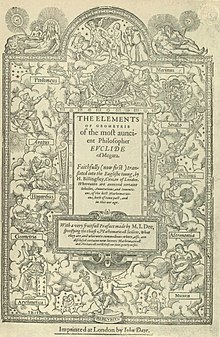Euclid's Elements

The frontispiece of Sir Henry Billingsley's first English version of Euclid's Elements, 1570
|
|
| Author | Euclid, and translators |
|---|---|
| Language | Ancient Greek, translations |
| Subject | Euclidean geometry, elementary number theory |
| Genre | Mathematics |
|
Publication date
|
circa 300 BC |
| Pages | 13 books, or more in translation with scholia |
Euclid's Elements (Ancient Greek: Στοιχεῖα Stoicheia) is a mathematical and geometric treatise consisting of 13 books attributed to the ancient Greek mathematician Euclid in Alexandria, Ptolemaic Egypt circa 300 BC. It is a collection of definitions, postulates (axioms), propositions (theorems and constructions), and mathematical proofs of the propositions. The books cover Euclidean geometry and the ancient Greek version of elementary number theory. The work also includes an algebraic system that has become known as geometric algebra, which is powerful enough to solve many algebraic problems, including the problem of finding the square root of a number.Elements is the second-oldest extant Greek mathematical treatise after Autolycus' On the Moving Sphere, and it is the oldest extant axiomatic deductive treatment of mathematics. It has proven instrumental in the development of logic and modern science. According to Proclus, the term "element" was used to describe a theorem that is all-pervading and helps furnishing proofs of many other theorems. The word 'element' in the Greek language is the same as 'letter'. This suggests that theorems in the Elements should be seen as standing in the same relation to geometry as letters to language. Later commentators give a slightly different meaning to the term element, emphasizing how the propositions have progressed in small steps, and continued to build on previous propositions in a well-defined order.
...
Wikipedia
